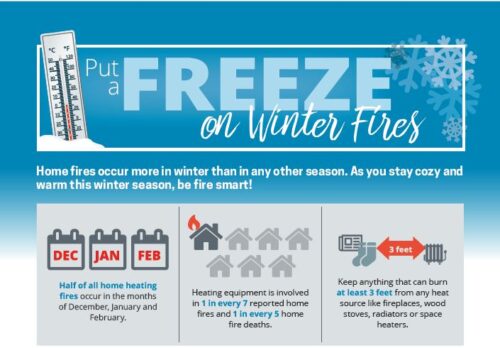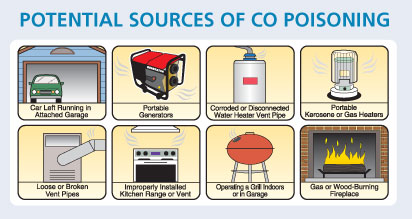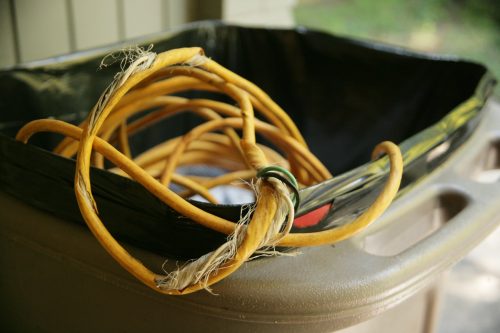
Heating, holiday decorations, winter storms and candles all contribute to an increased risk of fire during the winter months. Home fires occur more in winter than in any other season. As you stay cozy and warm this winter season, follow these fire safety tips to be #NCFDSafe this winter!
Heating Safety
Heating is the second leading cause of U.S. home fires, deaths and injuries. December, January and February are the peak months for heating fires. Space heaters are the type of equipment most often involved in home heating equipment fires, figuring in two of every five fires (40%). More statistics on heating fires.
- Keep anything that can burn at least 3 feet from any heat source like fireplaces, wood stoves, radiators or space heaters.
- Remember to turn portable heaters off when leaving the room or going to bed.
- Have a three-foot (one meter) “kid-free zone” around open fires and space heaters.
- Have heating equipment and chimneys cleaned and inspected every year by a qualified professional.
- Always use the right kind of fuel, specified by the manufacturer, for fuel burning space heaters.
- Make sure the fireplace has a sturdy screen to stop sparks from flying into the room. Ashes should be cool before putting them in a metal container. Keep the container a safe distance away from your home.
- Never use your oven to heat your home.
Carbon Monoxide Safety
Often called the invisible killer, carbon monoxide (CO) is an odorless, colorless gas created when fuels such as gasoline, wood, coal, propane, etc. do not burn completely. In the home, heating and cooking equipment that burn fuel are potential sources of CO. Carbon monoxide incidents are more common during the winter months, and in residential properties.
- CO alarms should be installed in a central location outside each sleeping area and on every level of the home and in other locations where required by applicable laws, codes or standards. For the best protection, interconnect all CO alarms throughout the home. When one sounds, they all sound.
- Follow the manufacturer’s instructions for placement and mounting height.
- Choose a CO alarm that is listed by a qualified testing laboratory.
- Test CO alarms at least once a month; replace them according to the manufacturer’s instructions.
- If the CO alarm sounds, immediately move to a fresh air location outdoors or by an open window or door. Make sure everyone inside the home is accounted for. Call for help from a fresh air location and stay there until emergency personnel declare that it is safe to re-enter the home.
- If you need to warm a vehicle, remove it from the garage immediately after starting it. Do not run a vehicle or other fueled engine or motor indoors, even if garage doors are open. Make sure the exhaust pipe of a running vehicle is not covered with snow.
- Gas or charcoal grills can produce CO — only use outside.
Electrical
Electrical home fires are a leading cause of home fires in the U.S. There are approximately 45,000 home electrical fires each year. Roughly half of all home electrical fires involved electrical distribution or lighting equipment, while nearly another half involved other known types of equipment like washer or dryer fans, and portable or stationary space heaters. Home electrical
fire deaths peak between midnight and 8 a.m. More statistics on electrical fires.
- Electrical work should ONLY be done by a qualified electrician.
- Check your electrical cords. If they are cracked or damaged, replace them. Don’t try to repair them.
- Don’t overload extension cords or wall outlets.
- Never use extension cords with appliances. Plug them directly into wall outlets.
Winter Storm Safety
Severe weather can happen at any time, in any part of the country. That’s why it’s important for you to be ready for severe weather events — and to understand the fire risks that can come with them.
- Test smoke and carbon monoxide alarms.
- Make sure your smoke alarm has a backup battery.
- Review your home fire escape plan.
- Use surge protectors.
- Consider unplugging appliances.
- Never use candles for emergency lighting. Many things in your home can catch fire if they come too close to a candle’s flame.
- Disconnect motor vehicle batteries in flood-prone areas.
- Take steps to prevent pipes from freezing and heat escaping from your home.
- Never use your oven to heat your home.
Generator Safety
Portable generators are useful during power outages, however, man y homeowners are unaware that the improper use of portable generators can be risky. The most common dangers associated with portable generators are carbon monoxide (CO) poisoning, electrical shock or electrocution, and fire hazards. According to a 2013 Consumer Product Safety Commission report, half of the generator-related deaths happened in the four coldest months of the year, November through February, and portable generators were involved in the majority of carbon monoxide deaths involving engine-driven tools.
y homeowners are unaware that the improper use of portable generators can be risky. The most common dangers associated with portable generators are carbon monoxide (CO) poisoning, electrical shock or electrocution, and fire hazards. According to a 2013 Consumer Product Safety Commission report, half of the generator-related deaths happened in the four coldest months of the year, November through February, and portable generators were involved in the majority of carbon monoxide deaths involving engine-driven tools.
- A generator should be used in a well-ventilated location outdoors away from windows, doors and vent openings.
- Portable generators are useful during winter storms, but if not used safely, they can cause injuries and death.
- Use portable generators outdoors in well-ventilated areas away from all doors, windows and vents.
- Make sure you have carbon monoxide alarms in your home.
- Do not use a generator in a wet area. This can cause shock or electrocution.
- Connect appliances to the generator with heavy-duty extension cords.
- Do not fuel your generator when it is running. Spilling gas on a hot engine can cause a fire.
Candles
December is the peak time of year for home candle fires; the top two days for home candle fires are Christmas and Christmas Eve. Each year between 2013-2017, an average of 7,900 home candle fires were reported each year.
- Put candles in sturdy holders.
- Place candles at least 12 inches away from anything that can burn.
- Make sure candles cannot be reached by children or pets.
- Blow out all candles if you leave the room, get sleepy, or go to bed.
